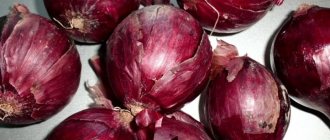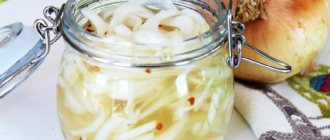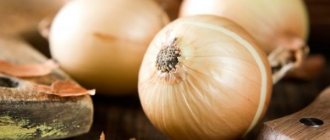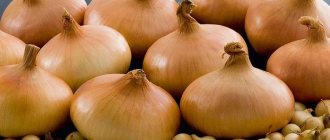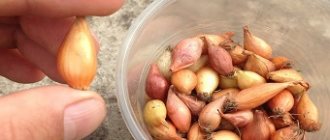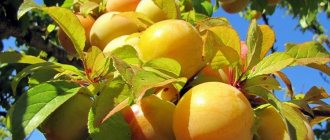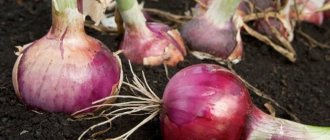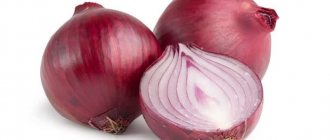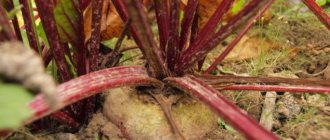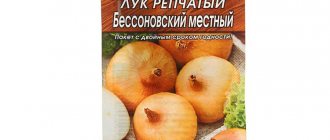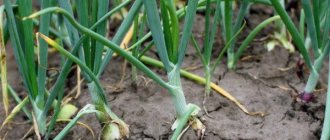Main characteristics of Yalta onion
Yalta onion belongs to the mid-season varieties. The growing season of the vegetable takes from 150 to 160 days. Growing requires special climate and weather conditions. Prefers clay and shale soil.
Buying real Yalta onions is only possible in Crimea.
The flat-round, flattened bulbs have large, dense feathers with a coating of wax. The average weight of a specimen is 150 g, the height of the arrows exceeds 1.2 m. The formation of greenery is a long process, cultivation is only by seedlings.
The lettuce variety has red heads, sometimes with a blue tint. The juicy scales are white in color, with possible pink tints. Its thickness is approximately 7 mm. Onions have a sweet taste with a slight bitterness.
The chemical composition of the Yalta variety includes ascorbic acid, allicin, and coarse fiber. The content of essential oils ensures the absence of a sharp onion smell. When consuming the red product, the mucous membranes are not irritated. Calorie content of 100 grams of Yalta onion is 32 kcal. The first harvest begins with the arrival of summer; harvesting of red vegetables is completed, as a rule, in September.
Where does Yalta onion grow?
Where in Crimea are real Yalta onions grown? Red vegetable is the calling card of Crimea. The original product is difficult to buy. The crop is zoned on plantations located near Alushta in the settlements of Zaprudnoye and Lavrovoe. Near the resort of Simeiz, in the villages of Opolznevoe and Blue Bay, Crimean onions are also grown.
Being close to the sun, a mountain climate, water from a spring to feed a vegetable plot, and rocky soil accumulate and retain heat for a long time, giving the plant original taste properties.
More than once they tried to breed the red variety in the steppes of Crimea, in Kazakhstan and Ukraine, in the Moscow region and in the Urals, but to no avail. Outside the mountains it is impossible to obtain a high-quality product.
The secret of the taste of the Crimean vegetable lies in the growing conditions. Seed material in other areas loses its unique qualities, and as a result an ordinary red onion grows, which also tastes bitter. If vegetables are grown in a greenhouse, they lose their natural juiciness and sweetish taste.
The ancestor of the Crimean vegetable is a flat red onion, imported in the 19th century from the Portuguese island of Madeira in the Atlantic.
History of selection
There is another version, according to which the product was brought from Spain in the 19th century. The difference between the Crimean onion variety is large bulbs with red skin and white flesh, plus a taste without bitterness.
Local scientists became interested in the plant. In the first half of the 20th century, a decision was made to breed the crop in the Nikitsky Botanical Garden. This is how another name for the red vegetable appeared: Nikitsky. The Crimean variety is the result of crossing “foreign” plants: flat-round varieties with a purple color that came from the island of Madeira, and a sweet variety from Spain. For more than a hundred years, Crimean scientists have been preserving and improving the variety. The main onion properties are determined by the climate of the Crimean Peninsula:
- soil composition;
- mountain air;
- duration of daylight hours.
How to choose the right one
The increased demand for the red product leads to attempts to pass off other varieties as Crimean onions. Unscrupulous traders try to deceive by offering similar products that look similar. They resort to tricks: painting fakes in ink or potassium permanganate solutions. When buying goods on a highway or market, you can buy an ordinary field vegetable, which is zoned on an industrial scale in Crimea.
How to choose the right Yalta onion? Trying the product will help you avoid mistakes when purchasing. The mild taste with sweet notes indicates that the product is real. You can ask to cut a red onion. The section reveals thick white layers of Yalta onions with a pinkish or purple border. The steppe variety has thinner layers and more of them.
It is preferable to buy a well-dried product in August. The quality of the Crimean onion is evidenced by the dry tail and cracked husk.
What are the benefits of Yalta onion?
Including red vegetables in your diet has a positive effect on your well-being. The mineral and vitamin composition is responsible for the beneficial properties of Yalta onions:
- increasing immunity;
- anti-inflammatory effect;
- prevention of tumor development;
- lowering cholesterol levels;
- removal of toxins;
- improvement of vascular condition;
- increased collagen production;
- blood pressure stabilization;
- fight against parasites.
Traditional healers recommend introducing the red product into your diet to strengthen the central nervous system and forget about insomnia and nervousness. Eating the product has a positive effect on the functioning of the cardiovascular system, brain, and digestive organs.
Crimean onion - the red pearl of the southern coast
Holidays in Crimea are not only sun and souvenir magnets. Experienced tourists return home with a bunch of aromatic, delicious Crimean onions. But what's the catch? How to distinguish real Yalta from the rest? The article below reveals all the secrets.
Description
The uniqueness of the Crimean variety is explained by the fact that it is almost impossible to grow anywhere except the Crimean coast. The famous onion grows actively in clay soil; it can also be planted in slate soil. The cultivation of red onions is also complicated by the particular demands of the variety on the climate: plantings require constant bright lighting and suitable soil with a greenhouse effect.
The growing cycle lasts for 2 years. First, the seeds are sown and small seed heads are obtained. Next year, gardeners are already harvesting a full-fledged harvest suitable for food. The feathers of mountain onions are distinguished by their increased density; they seem to be covered with a waxy coating. The height of the arrows can reach 120 cm. The bulbs themselves are also not far behind in size - the average one weighs 150 g.
The Crimean variety is valued for its composition. The juice of the mountain vegetable contains a record amount of antioxidants and vitamins, and contains essential oils.
https://www.youtube.com/watch?v=bN1FBF_KUL0
Most often, mountain Crimean onions are confused with steppe onions that are similar in appearance. The error becomes obvious at the first close examination of the heads. True gourmets are able to distinguish varieties based on taste.
Authentication
Unscrupulous sellers often deceive tourists by placing a couple of similar onions in bundles. Some manage to purchase a bunch that does not contain a single head of the original Crimean onion. Most often, the mountain variety is confused with the steppe variety - they are similar in appearance, but knowing the distinctive features of the original, it will be much easier to understand.
So, how does the true Crimean look differ from the rest?
- The scales of the mountain onion fit tightly to each other. The more difficult it is to separate them from each other, the more likely it is that it is the original variety.
- Each layer is white. Only the skin is purple or deep pink. You can verify this by cutting the onion - the white stripes will be much thicker than the rest.
- The smell of real onions will not cause tears or coughing. The variety has a mild aroma and delicate taste with sweet notes. An elusive and therefore piquant spiciness is possible.
- The shelf life of the vegetable is short, onions are stored for no more than 4 months, after which the presentation and beneficial properties of the product begin to decline. The culture ripens in mid-summer. Onions appear on the shelves at this time. If the seller offers Crimean onions in the spring, this is an obvious fake.
Attention! Mountain pink onions do not separate. The skin fits tightly, the heads are strong.
Distinctive properties
The southern vegetable is a wonderful addition to any dish; it tastes soft in fresh salads and adds a sophisticated aroma to roasts. However, this is not the only advantage of the variety. Fans of the purple vegetable note its incredible healing power.
What are the benefits of Yalta onion:
- Regular consumption of the vegetable is recommended for people suffering from high blood pressure. Onion juice helps reduce cholesterol levels and improves the functioning of the cardiovascular system.
- The vegetable is rich in sulfur, its effect is aimed at increasing skin elasticity. Toxins are removed from the body, lightness returns and energy is replenished.
- The variety can act as a prophylactic agent: it reduces the risk of cancer and triggers metabolic processes.
Advice. Also, do not forget about the dietary effect of regular consumption of the Yalta vegetable. Low calorie content and high fiber content put the product in first place among others.
The mountain variety is also indicated for excessive excitability. It has a calming effect, restores the nervous system and relieves migraines.
Tips for use
There are no separate recipes for the Crimean delicacy. Onions can be used in preparing absolutely any dish. However, it should be remembered that heat treatment deprives the vegetable of most of its beneficial properties. This is why experienced chefs prefer to use purple heads in fresh salads.
If you had to use the product for the first or second course, it is important to know that the color of the skin will turn pale - this is a natural process and does not indicate a fake.
The healing properties of onions are varied and are especially evident in folk medicine:
- Rubbing with fresh juice can speed up recovery from a cold and activate the body's defense mechanisms. It is not difficult to prepare a mixture for rubbing; just mix the grated onion with honey.
- The Yalta onion is also useful for expelling parasites. The tincture is prepared very simply: several scales are poured with warm water and infused for at least 7 hours. You need to drink the healing solution for a week.
- It is not recommended to give the product to children under 2 years of age, because The juice contains active ingredients - there is a chance of burning the mucous membrane.
The peculiarities of the red Yalta onion are both its advantage and the reason for the appearance of a large number of fakes.
Yalta bow: video
Source: https://sad24.ru/konservaciya/lekarstvennye/krymskij-luk.html
Use in cooking
It is preferable to eat Yalta onions fresh. Snacks are prepared from the red vegetable; it is added to side dishes and salads. The bulbs go well with meat, fish, and muscat wine. The following dishes are prepared with the addition of red product:
- shashlik;
- soups;
- baked chicken;
- meatloaf;
- pizza;
- savory baked goods;
- pickled tomatoes.
Diced Crimean onions can be added to stews and savory roasts, or added to a hot dog or burger. The cooked food is juicy and has a pleasant taste. Yalta onions are a tasty choice for people who care about their health. A recipe for Crimean salad is highlighted. Components:
- Crimean onion – 2 pcs.;
- salt, herbs, vegetable oil;
- white cabbage – 350 g;
- bell pepper – 2 pcs.
How to cook:
- Cut the vegetables: red onion into rings, pepper into strips, cabbage into strips.
- Chopping greens.
- Mix the ingredients.
- Salt, season with oil.
The product is a must-have vegetable in the kitchen pantry.
Application in cosmetology
What is the real Yalta onion famous for? The red product is used for cosmetic purposes. Improves the condition of the skin, helps with dermatological problems. Masks based on Crimean onions for hands and face make the skin softer and restore youth. Onion juice is indispensable for acne. Its use makes age spots invisible. Red onion pulp strengthens hair follicles. To achieve the effect, rub the product into the scalp. After half an hour, the composition is washed off and the hair is thoroughly washed with shampoo.
Diseases and pests
- Onions are most often affected by downy mildew. This can be avoided by performing preventive treatments with Aliette 80% s. n. or 1% Bordeaux mixture.
- The main pests of onions are thrips and onion fly. To fight them, use Enzhio or Aktara. These chemical plant protection products should be used strictly following the instructions.
Features of growing Yalta onions
The price of the Crimean variety is high. The growing season lasts 5 months or more. The vegetable is grown from seeds using seedlings. The demanding crop grows only on irrigated soil. The cultivation of Crimean onions is carried out by farmers and gardeners in the private sector. It is not always possible for summer residents to visit the site every day and provide quality care for onion seedlings.
Landing
Seed material is sown in the 3rd decade of February. Adhere to the following algorithm:
- Seed treatment. Disinfect planting material for half an hour in a pink solution of potassium permanganate. Then the seed is washed and immersed in a growth stimulator: Biostim, Heteroauxin, Etamon or Immunocytophyte.
- Preparing plastic or wooden containers. Fill the boxes with soil for seedlings to a depth of 15 cm. It is possible to use a substrate for which turf soil and humus are taken in equal parts. It wouldn’t hurt to add 70 g of mineral complex fertilizers.
- Sowing. Furrows are made in the containers, the seeds are buried 1 cm. The interval between rows is 6 cm.
- Temperature conditions. The container, covered with polyethylene, is kept at room temperature. When sprouts appear, the temperature is reduced to +12 °C. After a week, it is increased by 6 °C.
- Spraying. Spray the seedlings daily over the leaves from a spray bottle.
- Hardening. 1 or 2 weeks before planting in the beds, the plants are hardened off: they are taken out into the fresh air, gradually increasing the time spent outside. At the same time, the seedlings are thinned out, removing weak shoots.
- Picking. The formation of 4 leaves indicates that it is time to replant the crops. In the south of Crimea, the procedure falls at the beginning of April.
To grow Yalta onions in unprotected soil, you will need sunlit beds, not blown by draft winds, and rich in nutrients.
When planting, do not forget about the rules of crop rotation. It is advisable to plant the plant after white cabbage, tomatoes, potatoes, cucumbers, and herbs. Bad predecessors for red vegetables are other onion varieties.
When planting seedlings, proceed according to the following scheme:
- maintain a distance of 40 cm between rows;
- holes are made in increments of 10 cm;
- young crops are placed in holes at a depth of 4 cm, dug in, and watered.
With this planting technology, 35 onion bushes are placed on a square area.
Care
To get a good harvest of red onions, it is important to properly care for the plants. Agrotechnical measures for caring for Crimean onions include:
- Regularity of watering. Drying out the soil is fraught with loss of sweetness and pungency of red onions. The irrigation method is used to water crops between rows. Water requirement: +20…+22 °C. Feeding red plants is completed 3 weeks before harvest to enhance the keeping quality of the bulbs.
- Loosening. The formation of a crust on the soil prevents loosening. Large heads will not form if you ignore this agricultural technique. Lack of moisture and oxygen are the culprits. At the same time, the area is cleared of weeds, which shades the onion plantings and prevents the development of red plants.
- Fertilizers. Seedlings are fed every 2 weeks, feeding is applied one at a time. They use organic matter - mullein, which is diluted 1 to 5. When using chicken manure, prepare the product in a ratio of 1 to 10. For phosphorus-potassium supplements, you will need potassium chloride (20 g) and superphosphate (40 g) per bucket of water.
It is undesirable to exceed the dosage of fertilizers so as not to harm plants and humans.
Disease and pest control
Sweet Yalta onions are characterized by resistance to plant diseases. However, waterlogging is the cause of fungal diseases. The roots of the crop may rot or downy mildew may develop. Moderate but frequent watering is appreciated. For prevention, Crimean onions are processed:
- Bordeaux mixture (1%) – at the stage of rooting seedlings;
- Arceride (0.4%) – 14–21 days after the 1st treatment;
- with the same composition – on the 20th day after the 2nd manipulation.
Planting seedlings in open ground
Mature seedlings need to be transplanted into prepared soil, following the following instructions:
- Water the sprouts generously, carefully pouring water under their roots.
- Slowly remove young plants from the container, shorten their roots and leaves (by about half their length).
- Water the soil generously and plant the sprouts on the plot using a wide-row pattern:
- the distance between plants in a row is 8-10 cm;
row spacing – 35-40 cm;
- groove depth – 4 cm.
- After planting, cover the onion roots with soil, gently compact and water.
Adhering to these planting parameters, per 1 sq. m of beds it will be possible to place approximately 35 seedlings.
Harvesting and storage
If onion foliage falls en masse, it’s time to harvest. The harvest of red vegetables begins later compared to ordinary onions: the last ten days of August - the beginning of September. Ripe bulbs are dug up, otherwise autumn rains will cause them to rot. Digging up the plants with a pitchfork will make it easier to remove the red heads. How to store Crimean onions? When storing bulb crops, adhere to the following rules:
- the temperature in the basement does not exceed +10…+15 °C;
- requires dry air, low humidity (up to 50%).
Red onions are braided to prolong their shelf life and hung from the ceiling. Storing in a bundle ensures ventilation and prevents the bulbs from molding. The red heads remain in cool conditions for 2 to 4 months. Then the variety germinates. Onions are not suitable for long-term storage. It is prohibited to store the red product in plastic bags. A wooden container will fit.
Why real Yalta onions don’t last long
The Crimean variety does not last long: it contains sugar and water in large quantities. This is a genetic feature of the red product.
Red onion prices peak in May as last year's supplies are used up. The goods are inexpensive in June: the early harvest has ripened, few tourists rest. The high quality of the product is noted in July-August, when there are sunny days.
Differences from other varieties
Externally, real Yalta onions are similar to other varieties of the same red onions. But there are differences, and there are quite a lot of them. In order not to buy a fake, you need to be able to determine the authenticity by appearance and organoleptic properties.
The difference between the Yalta mountain onion and others:
| Characteristic | Yalta | Other varieties of red onions |
| Bulb | flat, round, large | flat, round, medium or large |
| Inner layers | thick (6–7 mm) | thin (3–5 mm) |
| Number of layers per cut | 7 | different quantities |
| Layer color | pale pink with purple trim | usually white with or without edging |
| Peel | thick, dense | thinner |
| Taste | sweet, no bitterness | perhaps sweet, but there will be some bitterness |
| Onion smell | absent | present |
| Best before date | about 2–4 months | different |
| For sale | only in July | Anytime |
It must be taken into account that the variety in question ripens in July and can be sold no longer than it will be stored, therefore the onions that are sold in the spring are not Nikitinsky.
Did you know? Ancient texts from Egypt, Greece and India tell of the use of onions as an aphrodisiac. For example, in Egypt, priests were forbidden to eat it due to the effect it had on their libido, and in medieval Europe it was served to newlyweds on the morning of their wedding night.
Contraindications and harm from Yalta onions to the body
When consumed, the benefits of Yalta onions for the body are felt. But before introducing it to the menu, it is advisable to familiarize yourself with the restrictions. Red vegetables are contraindicated for people who suffer from:
- kidney pathologies;
- liver diseases;
- intestinal dysfunction.
For patients with high stomach acidity, it would be a good idea to limit the consumption of red foods so as not to worsen the situation.
It is advisable to include Yalta onions in your diet in small portions. Consumption of 150 g of red product daily increases the risk of acidity, hence the appearance of heartburn, abdominal discomfort, and nausea. Avoidance of vegetables is necessary in case of individual intolerance.
Consumption of flat Crimean onions will benefit the body and have a beneficial effect on health. The main thing is to eat in moderation, if there are no contraindications. In addition, the red vegetable is popular in cosmetic recipes. But you can grow real Yalta onions only in the south of Crimea, where natural conditions are responsible for the sweetness of the healthy red vegetable.
Preparing the bed and soil for planting
By the beginning of October, all soil preparation should be completed. Necessary:
- weed and remove weeds;
- apply fertilizer (preferably organic);
- carry out deep digging of the earth, followed by harrowing.
All this preparatory work will help the soil accumulate moisture over the winter. Before directly planting seedlings in the ground in the spring, the soil must be kept clean and loose. Choose a place for the garden bed where the sun can warm the ground all day. You should abandon the area where melt water stagnates for a long time.
Best predecessors:
- peas;
- beans;
- potato;
- tomatoes.
Do not use a site where other types of onions grew.
